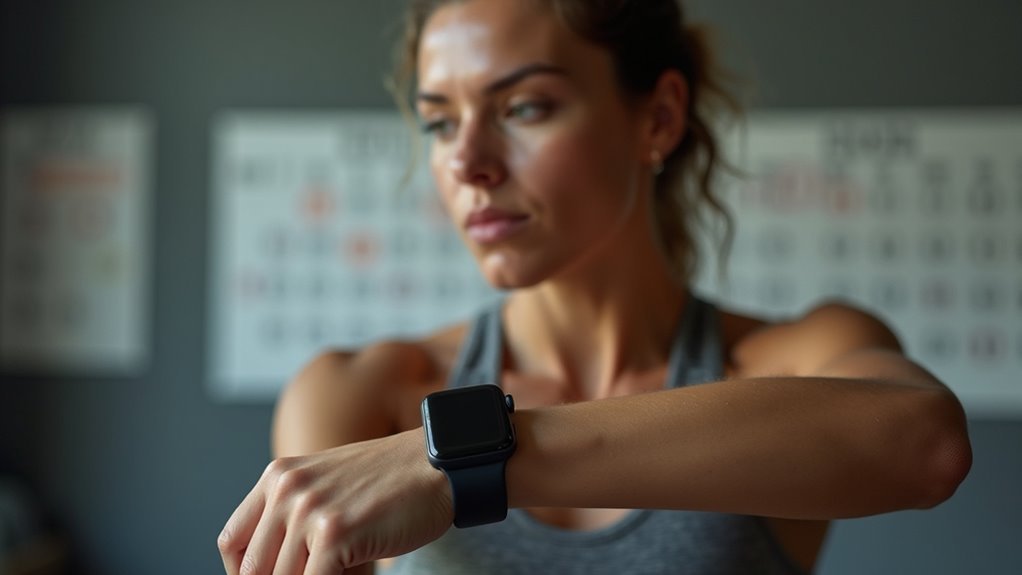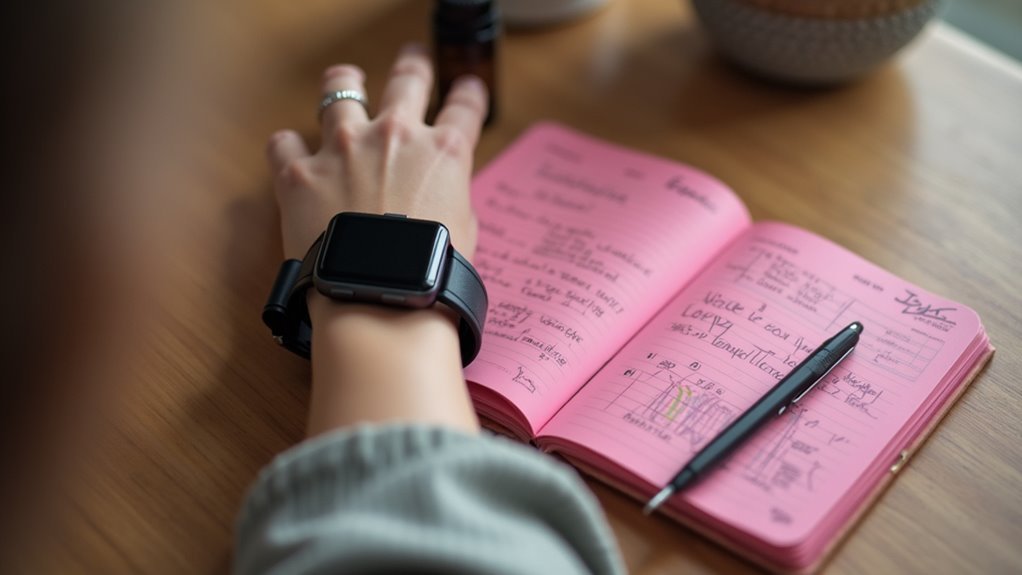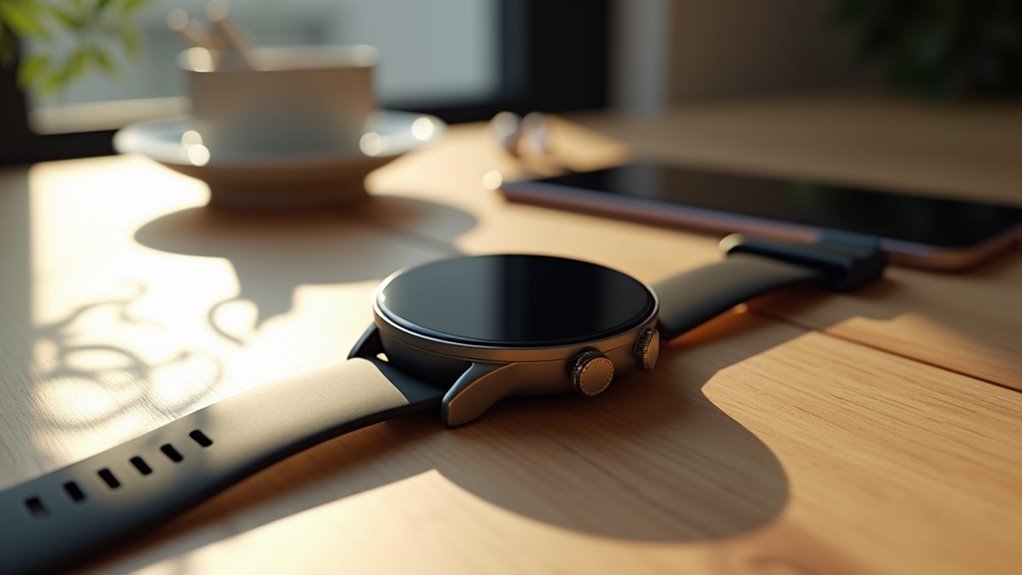You can track your menstrual cycle with fitness watches using advanced temperature sensors and heart rate monitoring that detect hormonal changes throughout each phase. Devices like Apple Watch Series 8 and Oura Ring continuously collect data to predict ovulation windows with up to 90% accuracy, while also monitoring sleep patterns, mood changes, and other symptoms. These wearables integrate cycle data with fitness metrics, helping you optimize workouts and manage health symptoms more effectively through personalized insights.
Understanding Menstrual Cycle Tracking Technology in Fitness Watches
When you’re tracking your menstrual cycle with fitness watches, you’re leveraging sophisticated technology that goes far beyond basic calendar reminders.
Modern devices like the Apple Watch Series 8 and Oura Ring use advanced temperature sensors to monitor body temperature changes, greatly improving prediction accuracy. You’ll find that devices continuously collect data to refine their algorithms over time, making predictions more reliable with each cycle.
The technology integrates seamlessly with extensive health platforms, storing your menstrual data alongside fitness metrics in apps like Apple’s Health app or Garmin Connect.
These systems analyze patterns retrospectively to identify potential health issues while providing real-time insights about ovulation and fertile windows. You can customize inputs beyond basic period tracking, logging flow intensity, mood changes, and ovulation test results for enhanced personalization. Devices can send notification reminders about upcoming periods to help you prepare and plan ahead.
Key Physiological Markers Measured by Wearable Devices
As your fitness watch continuously monitors your body throughout the day, it’s measuring several key physiological markers that reveal important insights about your menstrual cycle.
Your resting heart rate fluctuates with hormonal changes, often increasing slightly before ovulation. Heart rate variability indicates stress levels and hormonal shifts, helping detect different cycle phases.
Your body’s subtle heart rate changes serve as a natural indicator of hormonal shifts throughout your menstrual cycle.
The device tracks minute changes in your skin temperature, which can predict ovulation as your basal body temperature rises afterward. Your breathing patterns also vary subtly throughout your cycle due to hormonal influences.
Additionally, the watch monitors blood flow changes through perfusion measurements, reflecting your body’s physiological shifts. Research shows that finger temperature exhibits clear oscillatory patterns that indicate ovulatory cycles in the vast majority of women.
These combined markers create a thorough picture of your reproductive health, enabling more accurate cycle tracking than traditional methods alone.
Popular Fitness Watch Brands and Their Cycle Tracking Features
Since the market now offers numerous fitness watch options with specialized menstrual cycle tracking capabilities, you’ll find distinct approaches and features across different brands.
Apple Watch integrates tracking into its Health app, using heart rate and temperature sensors to predict periods, fertile windows, and ovulation days.
Garmin’s Connect app lets you log flow and mood while providing training insights based on cycle phases.
WHOOP coaches you on managing sleep, strain, and stress throughout your cycle. The platform’s recommendations adjust based on research showing that strain tolerance varies significantly between the early follicular phase when muscle building is optimal and the late luteal phase when active recovery becomes more suitable.
Oura Ring focuses on temperature fluctuations to predict your next period six days in advance.
Each brand offers unique strengths—Apple’s thorough health integration, Garmin’s fitness-focused insights, WHOOP’s personalized coaching, and Oura’s temperature-based predictions.
How Sleep Monitoring Enhances Menstrual Phase Detection
While fitness watches excel at tracking steps and heart rate, their sleep monitoring capabilities reveal a deeper understanding of your menstrual cycle’s subtle patterns. Your sleep efficiency gradually declines throughout your cycle, with noticeable disruptions during the premenstrual period.
Devices like the Oura Ring achieve 74-98% accuracy in tracking sleep variables, detecting changes in heart rate and skin temperature that correspond to different menstrual phases.
Modern fitness watches use pattern recognition algorithms to identify specific cycle phases through your sleep data. By integrating sleep patterns with physiological signals, these devices provide extensive cycle tracking. These continuous signals from wearable sensors allow for more comprehensive monitoring compared to single-point measurements.
However, you’ll need to maintain consistent data collection for accurate results, as individual sleep variability can affect detection accuracy. This sleep-based approach offers valuable insights beyond traditional cycle tracking methods.
Optimizing Exercise Performance Through Cycle-Based Training

Your menstrual cycle creates distinct windows of opportunity for maximizing workout performance, and fitness watches can help you identify these ideal training phases.
During your follicular phase, you’ll want to focus on high-intensity workouts and strength training since estrogen peaks enhance muscle repair and endurance capacity. When you’re ovulating, capitalize on peak energy levels with explosive movements and challenging sessions.
As you enter the luteal phase, progesterone increases perceived effort and affects thermoregulation, so moderate your intensity and prioritize recovery.
During menstruation, opt for gentle activities like yoga or light cardio when energy’s naturally lower. Your fitness tracker’s cycle data helps you adjust training volume, prevent overtraining, and sync nutrition with hormonal fluctuations for peak performance gains. Research shows that women with regular cycles tend to exercise more consistently, averaging 20.6 minutes per day compared to 18.6 minutes for those with irregular cycles.
Predicting Fertile Windows and Period Timing With Wearables
Your fitness watch can predict when you’ll be most fertile by tracking specific physiological changes throughout your menstrual cycle.
The device monitors key markers like your basal body temperature and heart rate, which naturally fluctuate during different cycle phases.
When integrated with specialized apps, these continuous measurements become powerful tools that can forecast your fertile window and predict your next period with remarkable accuracy. Unlike devices that rely on user-input data, advanced wearables take skin temperature readings during sleep to provide more precise cycle tracking.
Physiological Markers for Prediction
Since wearable fitness devices can monitor multiple physiological signals simultaneously, they’ve become powerful tools for predicting your fertile windows and menstrual cycle timing.
Your heart rate varies throughout your cycle, providing valuable data points for prediction algorithms. These devices also track your interbeat intervals and respiratory rate, which change across different menstrual phases.
Electrodermal activity proves particularly useful, as its frequency patterns shift during ovulation. Your skin perfusion fluctuates throughout your cycle, offering another marker for tracking.
Machine learning algorithms analyze these combined physiological signals to detect fertile windows with approximately 90% accuracy. ARIMA models predict these signals with remarkably low error rates, while cosinor models assess temperature oscillations to identify cycle patterns and timing predictions. This data-driven approach empowers individuals to understand their reproductive health through comprehensive monitoring of hormonal changes.
App Integration and Accuracy
These sophisticated physiological tracking capabilities mean nothing without user-friendly apps that can interpret the data accurately for everyday use. Leading brands like Apple Watch and Garmin excel in this integration, offering detailed cycle tracking with intuitive interfaces that let you log symptoms and monitor different menstrual phases.
You’ll find these devices can accurately detect fertile windows by analyzing your physiological data, though period predictions often rely on past cycle patterns. For best results, you’ll need to consistently log your periods and manually adjust settings when necessary.
Many algorithms default to average cycle lengths, which won’t work for everyone. You can customize features like removing predictions or adjusting cycle lengths to improve accuracy, making these tools particularly valuable for managing irregular periods or conditions like PCOS. Modern trackers now incorporate temperature-sensing technology to provide more precise ovulation detection and fertility insights.
Managing Health Symptoms Through Integrated Cycle Data
You can track symptoms like mood changes, cramps, and energy levels directly through your fitness watch’s health app, creating a detailed picture of how your cycle affects your daily well-being.
This consistent logging helps you identify patterns and prepare for challenging days by adjusting your schedule or self-care routine accordingly. When you’re ready to share this information with healthcare providers, you can export as PDF for easy review during medical appointments.
Your wearable’s ability to correlate symptom data with cycle phases also enables early detection of irregularities that might warrant medical attention.
Symptom Logging Benefits
When you log symptoms like headaches, cramping, fatigue, and cravings alongside your cycle data, you’ll start recognizing consistent patterns that emerge over several months of tracking. This thorough symptom documentation creates powerful insights for managing your menstrual health proactively.
| Tracking Benefit | Impact | Example |
|---|---|---|
| Pattern Recognition | Identifies recurring symptoms | Monthly migraines on day 2 |
| Symptom Preparation | Enables preemptive strategies | Scheduling lighter workload during fatigue |
| Healthcare Communication | Improves medical discussions | Data-backed reports to doctors |
| Trigger Identification | Pinpoints exacerbating factors | Stress correlation with cramping |
You’ll notice that detailed logging helps distinguish between normal cycle variations and concerning changes requiring medical attention. The physiological data from fitness watches augments your symptom tracking, providing temperature fluctuations and sleep patterns that correlate with hormonal shifts, creating a multidimensional view of your menstrual health. Monitoring your resting heart rate and heart rate variability through these devices can reveal additional patterns that align with different menstrual cycle phases, offering deeper insights into your body’s rhythms.
Early Health Detection
Fitness watches equipped with cycle tracking capabilities can detect potential health issues months before symptoms become severe enough to seek medical attention. When you track temperature variations, cycle length, and period duration consistently, your device builds predictive models that can identify irregular patterns linked to conditions like PCOS and endometriosis.
Your Apple Watch or Fitbit analyzes this integrated data to generate risk scores, alerting you to potential reproductive disorders early. The Tempdrop device excels at precise temperature tracking, while menstrual apps enhance PCOS phenotypic characterization through thorough data collection. Advanced devices like the Oura Ring Gen 3 provide period prediction and fertility insights through comprehensive sleep and temperature monitoring.
However, you’ll find current technologies work best for regular cycles. If you experience highly irregular periods, these tools may have limitations, emphasizing the need for more inclusive technological development.
Future Innovations in Women’s Health Wearable Technology
As technology continues advancing at breakneck speed, the landscape of women’s health wearables is transforming with groundbreaking innovations that promise more personalized and accessible healthcare solutions.
You’ll soon see AI-driven devices like Peri tracking perimenopause symptoms while offering tailored health recommendations based on your unique data patterns. Non-invasive monitoring will revolutionize your experience through ultrasound-based blood pressure tracking and saliva hormone analysis, eliminating uncomfortable procedures while maintaining accuracy.
AI-powered wearables will deliver personalized health insights while non-invasive monitoring eliminates discomfort without sacrificing medical accuracy.
The convergence of AI, biomarkers, and personalized medicine means you’ll receive targeted insights specific to your body’s needs. Future devices will seamlessly integrate with existing health platforms, giving you real-time access to actionable data.
These innovations prioritize inclusive design, ensuring underserved communities gain access to advanced health tracking technologies previously unavailable to them. Addressing the critical funding gap in women’s health technology, initiatives like The Equalizer Challenge are emerging to support women-led innovations and scale these vital healthcare solutions globally.
Frequently Asked Questions
How Much Do Fitness Watches With Menstrual Cycle Tracking Typically Cost?
You’ll find budget fitness trackers with menstrual cycle tracking starting under $100, mid-range options between $100-$300, and premium smartwatches over $300. Costs vary greatly by brand and features you’re seeking.
Can Fitness Watches Track Cycles Accurately for Women With Irregular Periods?
You’ll find fitness watches struggle with irregular cycles since algorithms are optimized for regular patterns. However, continuous data collection and manual symptom logging can improve accuracy over time for your specific cycle.
Is Menstrual Cycle Data From Fitness Watches Private and Secure?
Your menstrual cycle data from fitness watches isn’t fully private or secure. It’s not HIPAA-protected, can be shared with third parties, and may face data breaches, so you’ll want stronger privacy protections.
How Long Does It Take for Fitness Watches to Learn Cycles?
Your fitness watch typically needs one complete menstrual cycle to start learning, but you’ll see improved accuracy after two to three cycles as the device’s algorithms better understand your unique patterns.
Do Fitness Watches Work for Cycle Tracking During Breastfeeding or Menopause?
Fitness watches struggle with cycle tracking during breastfeeding and menopause because irregular or absent periods disrupt their algorithms. You’ll find symptom logging more useful than cycle predictions during these life stages.




Leave a Reply